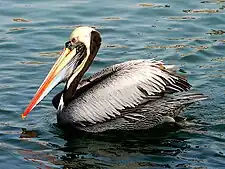| Peruvian pelican | |
|---|---|
 | |
| Scientific classification | |
| Domain: | Eukaryota |
| Kingdom: | Animalia |
| Phylum: | Chordata |
| Class: | Aves |
| Order: | Pelecaniformes |
| Family: | Pelecanidae |
| Genus: | Pelecanus |
| Species: | P. thagus |
| Binomial name | |
| Pelecanus thagus Molina, 1782 | |
 | |
| Synonyms | |
| |
The Peruvian pelican (Pelecanus thagus) is a member of the pelican family. It lives on the west coast of South America, breeding in loose colonies from about 33.5 degrees south in central Chile to Piura in northern Peru, and occurring as a visitor in southern Chile and Ecuador.[2] It used to be considered a subspecies of the brown pelican.
Description
These birds are dark in colour with a white stripe from the top of the bill up to the crown and down the sides of the neck. They have long tufted feathers on the top of their heads. It was previously considered a subspecies of the brown pelican (Pelecanus occidentalis). The Peruvian pelican is considerably larger, ranging from about 5 to 7 kg (11–15 lb) in weight, 137 to 152 cm (4.5–5.0 ft) in length and with a wingspan of about 228 cm (7.5 ft).[2][3] Compared to the brown pelican, it also has proportionally longer crest feathers, as well as differences in the colours of the gular pouch, beak, scapulars and greater wing coverts.[2]
Behaviour
Breeding
The main breeding season occurs from September to March. Clutch size is usually two or three eggs. Eggs are incubated for approximately 4 to 5 weeks, with the rearing period lasting about 3 months.
Breeding occurs in large coastal colonies.[4]
Feeding
Peruvian pelicans feed on several species of fish. Unlike the brown pelican, they never dive from a great height to catch its food, instead diving from a shallow height or feeding while swimming on the surface.[5][6] On occasion they may take other food items, such as nestling of imperial shags, young Peruvian diving petrels, gray gulls and cannibalize unrelated chicks of their own species.[7][8] They also feed on pelagic species such as anchovies.[6] In fact, those in the northern Humboldt Current System feed almost exclusively on one species, the Peruvian anchoveta.[9]
The birds feed around cold-water upwellings, being found along the Humboldt Current.[6]
Conservation
Its status was first evaluated for the IUCN Red List in 2008, being listed as Near threatened.[10] Its status was reassessed in 2018, and it was again listed as Near threatened, but with increasing population.[11]
One factor affecting their status may be competition with fishing industries for anchovies, a primary food source for the species.[4][9]
Gallery
 Peruvian pelican in Pan de Azúcar National Park, Chile
Peruvian pelican in Pan de Azúcar National Park, Chile Peruvian pelican in Pan de Azúcar National Park, Chile
Peruvian pelican in Pan de Azúcar National Park, Chile Several Peruvian pelicans at the Caleta Pan de Azúcar fishing village in Pan de Azúcar National Park, Chile
Several Peruvian pelicans at the Caleta Pan de Azúcar fishing village in Pan de Azúcar National Park, Chile_-_Weltvogelpark_Walsrode_2012-02_cropped.jpg.webp) A Peruvian pelican takes a bath at Weltvogelpark Walsrode, Germany
A Peruvian pelican takes a bath at Weltvogelpark Walsrode, Germany Peruvian pelicans in the Ballestas Islands, Peru
Peruvian pelicans in the Ballestas Islands, Peru Peruvian pelican in Paracas, Peru
Peruvian pelican in Paracas, Peru
References
- ↑ BirdLife International (2018). "Pelecanus thagus". IUCN Red List of Threatened Species. 2018: e.T22697619A132596827. doi:10.2305/IUCN.UK.2018-2.RLTS.T22697619A132596827.en. Retrieved 11 November 2021.
- 1 2 3 "Peruvian pelican". Handbook of the Birds of the World. Retrieved 21 May 2017.
- ↑ Schulenberg, Thomas S.; Stotz, Douglas F.; Lane, Daniel F.; O'Neill, John P.; III, Theodore A. Parker (2010-05-04). Birds of Peru: Revised and Updated Edition. Princeton University Press. ISBN 978-1-4008-3449-5.
- 1 2 "Peruvian Pelican (Pelecanus thagus) - BirdLife species factsheet". datazone.birdlife.org. Retrieved 2023-06-14.
- ↑ Jaramillo, A. (2009). "Humboldt Current seabirding in Chile". Neotropical Birding. 4: 27–39.
- 1 2 3 Jeyasingham, Will S.; Taylor, Scott A.; Zavalaga, Carlos B.; Simeone, Alejandro; Friesen, Vicki L. (2013). "Specialization to cold-water upwellings may facilitate gene flow in seabirds: new evidence from the Peruvian pelican Pelecanus thagus (Pelecaniformes: Pelecanidae)". Journal of Avian Biology. 44 (3): 297–304. doi:10.1111/j.1600-048X.2012.00004.x. S2CID 4288602.
- ↑ Cursach, J.A.; J.R. Rau; J. Vilugrón (2016). "Presence of the Peruvian Pelican Pelicanus thagus in seabird colonies of Chilean Patagonia". Marine Ornithology. 44: 27–30.
- ↑ Daigre, M.; P. Arce; A. Simeone (2012). "Fledgling Peruvian Pelicans (Pelecanus thagus) attack and consume younger unrelated conspecifics". Wilson Journal of Ornithology. 124 (3): 603–607. doi:10.1676/12-011.1. S2CID 84928683.
- 1 2 Passuni, Giannina; Barbraud, Christophe; Chaigneau, Alexis; Demarcq, Hervé; Ledesma, Jesus; Bertrand, Arnaud; Castillo, Ramiro; Perea, Angel; Mori, Julio; Viblanc, Vincent A.; Torres-Maita, Jose; Bertrand, Sophie (2016). "Seasonality in marine ecosystems: Peruvian seabirds, anchovy, and oceanographic conditions". Ecology. 97 (1): 182–193. doi:10.1890/14-1134.1. ISSN 0012-9658. JSTOR 24703004. PMID 27008787.
- ↑ BirdLife International (BLI) (2008) Peruvian Pelican Species Factsheet, 2008 IUCN Redlist status changes.
- ↑ BirdLife International. (2018). "Pelecanus thagus". IUCN Red List of Threatened Species. 2018: e.T22697619A132596827. doi:10.2305/IUCN.UK.2018-2.RLTS.T22697619A132596827.en. Retrieved 14 June 2023.
